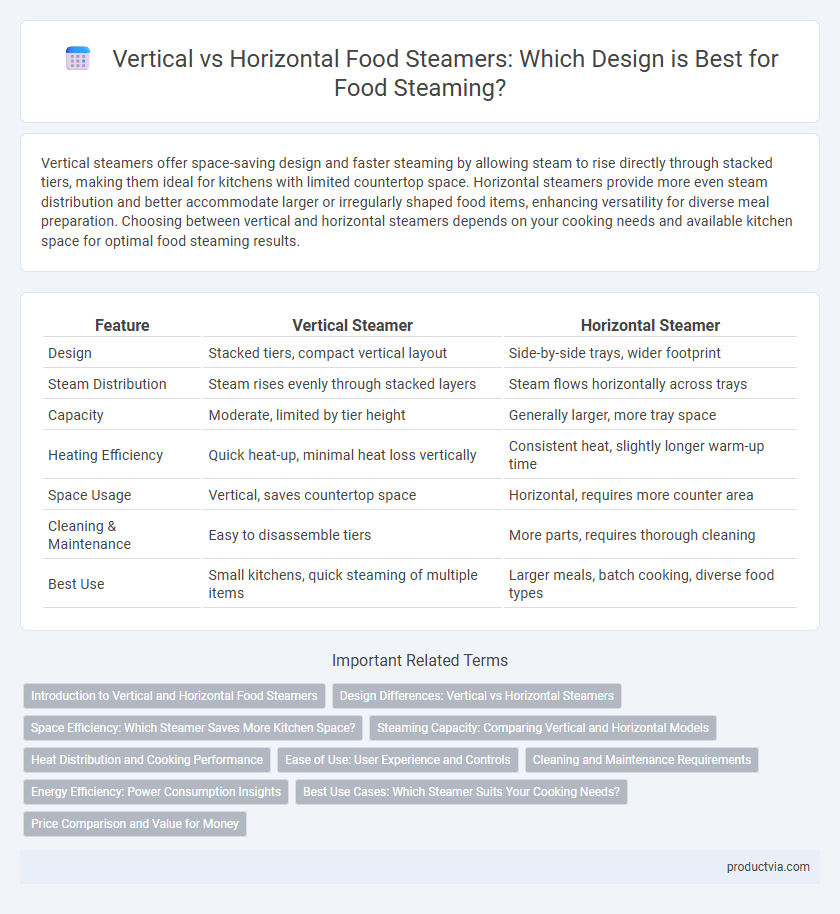Vertical steamers offer space-saving design and faster steaming by allowing steam to rise directly through stacked tiers, making them ideal for kitchens with limited countertop space. Horizontal steamers provide more even steam distribution and better accommodate larger or irregularly shaped food items, enhancing versatility for diverse meal preparation. Choosing between vertical and horizontal steamers depends on your cooking needs and available kitchen space for optimal food steaming results.
Table of Comparison
| Feature | Vertical Steamer | Horizontal Steamer |
|---|---|---|
| Design | Stacked tiers, compact vertical layout | Side-by-side trays, wider footprint |
| Steam Distribution | Steam rises evenly through stacked layers | Steam flows horizontally across trays |
| Capacity | Moderate, limited by tier height | Generally larger, more tray space |
| Heating Efficiency | Quick heat-up, minimal heat loss vertically | Consistent heat, slightly longer warm-up time |
| Space Usage | Vertical, saves countertop space | Horizontal, requires more counter area |
| Cleaning & Maintenance | Easy to disassemble tiers | More parts, requires thorough cleaning |
| Best Use | Small kitchens, quick steaming of multiple items | Larger meals, batch cooking, diverse food types |
Introduction to Vertical and Horizontal Food Steamers
Vertical food steamers feature a tall, space-saving design ideal for kitchen countertops, allowing multiple stacked trays for efficient steaming of vegetables, seafood, and dim sum. Horizontal food steamers provide a broader cooking surface suitable for larger items like whole fish or multiple dishes simultaneously, ensuring even heat distribution across the flat trays. Both steamers use convection heat and steam to retain nutrients and flavors, but the choice depends on kitchen space, volume, and types of food being prepared.
Design Differences: Vertical vs Horizontal Steamers
Vertical steamers feature a compact, space-saving design where steaming trays stack vertically, allowing efficient use of kitchen counter space and even steam distribution through the central column. Horizontal steamers spread trays side-by-side, offering easier access to individual compartments but requiring more countertop area, making them suitable for larger kitchens or batch cooking. The choice between vertical and horizontal steamers depends on kitchen space constraints and user preferences for accessibility and cooking volume.
Space Efficiency: Which Steamer Saves More Kitchen Space?
Vertical steamers offer a compact footprint, making them ideal for small kitchens by utilizing height rather than width, which saves counter space effectively. Horizontal steamers, while often providing larger capacity, tend to require more surface area, making them less space-efficient in tight environments. For kitchens with limited countertop area, choosing a vertical steamer maximizes space efficiency without sacrificing steaming performance.
Steaming Capacity: Comparing Vertical and Horizontal Models
Vertical steamers typically offer a larger steaming capacity due to their multi-tiered design, allowing simultaneous cooking of various foods in stacked compartments. Horizontal steamers provide more uniform heat distribution, which can be ideal for larger, single-layer items but often have a smaller overall capacity compared to vertical models. Choosing between vertical and horizontal steamers depends on the volume and types of food being prepared, with vertical steamers favored for bulk steaming and horizontal steamers preferred for even cooking of delicate items.
Heat Distribution and Cooking Performance
Vertical steamers offer superior heat distribution by allowing steam to rise evenly through stacked compartments, ensuring consistent cooking across multiple layers. Horizontal steamers provide more surface area for food, which can enhance browning and searing but may result in uneven steam circulation and hotspots. Choosing between vertical and horizontal steamers depends on the desired cooking performance, with vertical models excelling in uniform steaming and horizontal ones better suited for diverse cooking techniques requiring direct heat exposure.
Ease of Use: User Experience and Controls
Vertical steamers typically offer a more compact design with easy-to-access controls positioned on the front or top, enhancing user convenience and efficient counter space usage. Horizontal steamers provide a wider steaming area and often feature straightforward control panels, but their larger footprint can limit kitchen space and affect maneuverability. Users seeking quick access and simple operation may prefer vertical models, while those needing larger capacity might choose horizontal steamers despite a slightly less ergonomic layout.
Cleaning and Maintenance Requirements
Vertical steamers feature a compact design that facilitates easier access to individual trays, simplifying the cleaning process and reducing the time spent on maintenance. Horizontal steamers, due to their broader layout and interconnected trays, may require more effort to disassemble and thoroughly clean all components, especially in commercial kitchens with heavy usage. Choosing a vertical steamer can minimize residue buildup and streamline routine upkeep, enhancing overall hygiene and operational efficiency.
Energy Efficiency: Power Consumption Insights
Vertical steamers typically consume less power per steaming cycle due to their compact design that concentrates heat and steam efficiently. Horizontal steamers often require more energy because of their larger cooking chambers and longer heat distribution paths. Choosing a vertical steamer can lead to significant energy savings in commercial kitchens where frequent steaming is required.
Best Use Cases: Which Steamer Suits Your Cooking Needs?
Vertical steamers excel in steaming small batches of vegetables, dumplings, or seafood due to their compact design and efficient steam circulation, making them ideal for home kitchens with limited space. Horizontal steamers offer larger capacity and multi-tier stacking options, perfect for cooking multiple dishes simultaneously or preparing large meals in commercial or family settings. Choosing between vertical and horizontal steamers depends on cooking volume and space, with vertical models suited for quick, small-scale steaming and horizontal models better for extensive meal prep.
Price Comparison and Value for Money
Vertical food steamers typically offer a more affordable price range, making them an economical choice for budget-conscious consumers. Horizontal steamers often come with higher price points due to larger capacity and advanced features, providing greater value for households requiring extensive steaming capabilities. Considering long-term use, horizontal steamers deliver enhanced efficiency and versatility, justifying their elevated cost with improved durability and cooking performance.
Vertical steamer vs Horizontal steamer for Food Steaming Infographic

 productvia.com
productvia.com